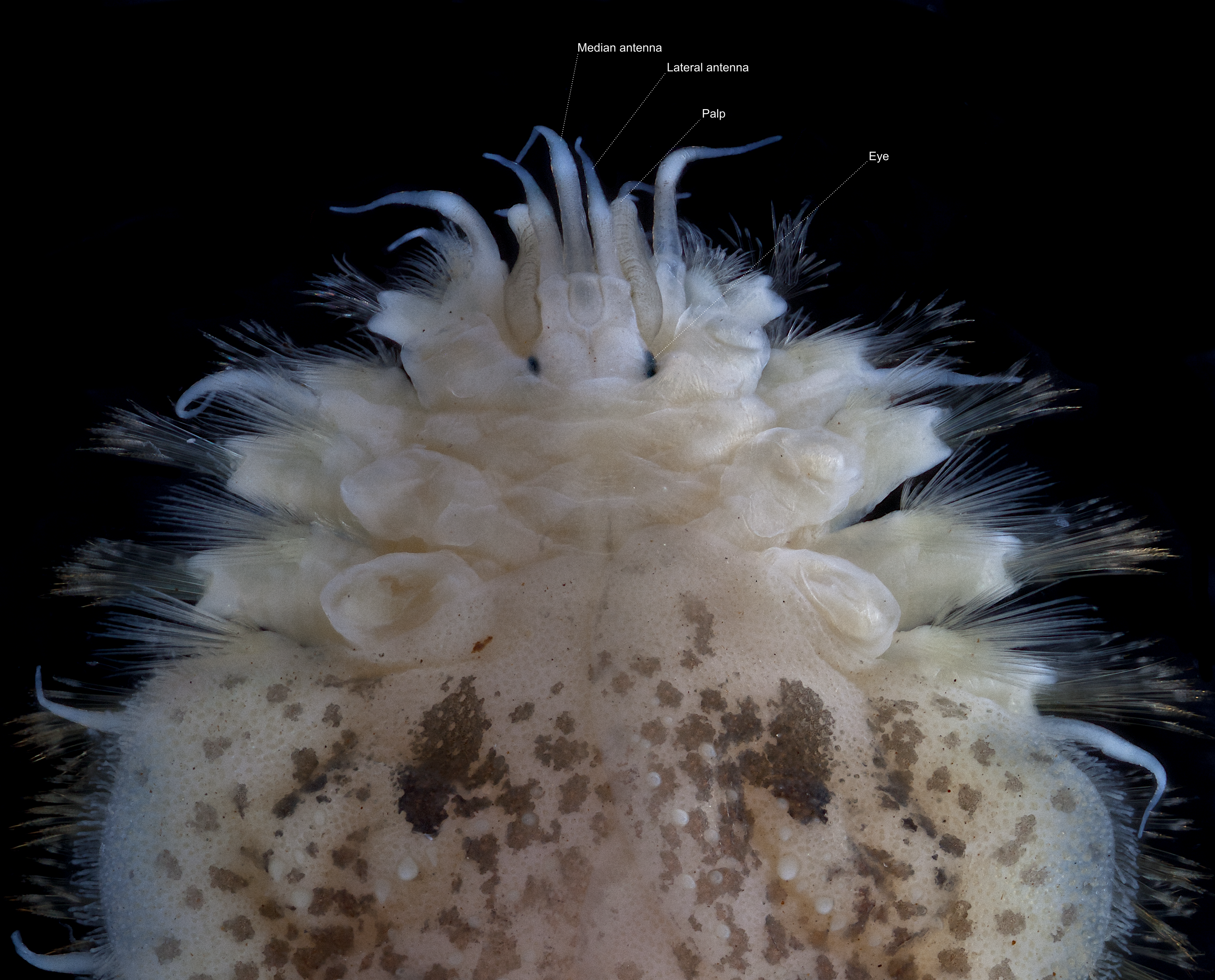|
Peristomium
The peristomium is the first true body segment in an annelid worm's body in the anterior end. It is directly behind the prostomium and contains the mouth, tentacular cirri, and sometimes feeding palps, which may instead occur on the prostomium. If an eversible pharynx is present, it is contained in this segment as well, and can fill up to 20 segments when inverted, depending on the species. The prostomium and peristomium can be variously fused, either completely distinct, or comprising a joint structure of a peristomial ring and a tentacular crown. See also *Prostomium *Pygidium The pygidium (plural pygidia) is the posterior body part or shield of crustaceans and some other arthropods, such as insects and the extinct trilobites. In groups other than insects, it contains the anus and, in females, the ovipositor. It is compo ... References {{Reflist Annelid anatomy ... [...More Info...] [...Related Items...] OR: [Wikipedia] [Google] [Baidu] |
Annelid
The annelids (Annelida , from Latin ', "little ring"), also known as the segmented worms, are a large phylum, with over 22,000 extant species including ragworms, earthworms, and leeches. The species exist in and have adapted to various ecologies – some in marine environments as distinct as tidal zones and hydrothermal vents, others in fresh water, and yet others in moist terrestrial environments. The Annelids are bilaterally symmetrical, triploblastic, coelomate, invertebrate organisms. They also have parapodia for locomotion. Most textbooks still use the traditional division into polychaetes (almost all marine), oligochaetes (which include earthworms) and leech-like species. Cladistic research since 1997 has radically changed this scheme, viewing leeches as a sub-group of oligochaetes and oligochaetes as a sub-group of polychaetes. In addition, the Pogonophora, Echiura and Sipuncula, previously regarded as separate phyla, are now regarded as sub-groups of polycha ... [...More Info...] [...Related Items...] OR: [Wikipedia] [Google] [Baidu] |
Prostomium
The prostomium (From Ancient Greek, meaning "before the mouth"; plural: prostomia; sometimes also called the "acron") is the cephalized first body segment in an annelid worm's body at the anterior end. It is in front of (but does not include) the mouth, being usually a small shelf- or lip-like extension over the dorsal side of the mouth. The prostomium together with the peristomium, which includes the mouth and pharynx, make up the annelid head. Description The prostomium is part of the head and holds at least part of the brain and often bears sensory structures such as the eyes, antennae and palps. It may function like a kind of overlip when the animal is feeding. The prostomium bears many important taxonomic characters and its shape and composition are important for annelid systematics. In addition to the eyes, antennae and palps, the prostomium can possess appendages such as tentacles or cirri. Moreover, some polychaete prostomia have a posterior extension or ridge with ... [...More Info...] [...Related Items...] OR: [Wikipedia] [Google] [Baidu] |
Prostomium
The prostomium (From Ancient Greek, meaning "before the mouth"; plural: prostomia; sometimes also called the "acron") is the cephalized first body segment in an annelid worm's body at the anterior end. It is in front of (but does not include) the mouth, being usually a small shelf- or lip-like extension over the dorsal side of the mouth. The prostomium together with the peristomium, which includes the mouth and pharynx, make up the annelid head. Description The prostomium is part of the head and holds at least part of the brain and often bears sensory structures such as the eyes, antennae and palps. It may function like a kind of overlip when the animal is feeding. The prostomium bears many important taxonomic characters and its shape and composition are important for annelid systematics. In addition to the eyes, antennae and palps, the prostomium can possess appendages such as tentacles or cirri. Moreover, some polychaete prostomia have a posterior extension or ridge with ... [...More Info...] [...Related Items...] OR: [Wikipedia] [Google] [Baidu] |
Cirrus (Polychaeta)
Cirrus may refer to: Science *Cirrus (biology), any of various thin, thread-like structures on the body of an animal * Cirrus (botany), a tendril *Infrared cirrus, in astronomy, filamentary structures seen in infrared light *Cirrus cloud, a type of cloud Aviation *Cirrus aero engines, a series of British aircraft engines manufactured by various companies from the 1920s to the 1950s *Cirrus Aircraft, an aircraft manufacturer in Duluth, Minnesota, USA *Cirrus Airlines, a defunct regional airline in Hallbergmoos, Germany *Cirrus (rocket), a German research rocket first launched in 1961 *Schempp-Hirth Cirrus, an Open-class sailplane *Schempp-Hirth Standard Cirrus, a Standard-class sailplane *Swing Cirrus, a German paraglider design Music * ''Cirrus'' (album), a 1974 release by Bobby Hutcherson *Cirrus (band), an American electronica duo * "Cirrus" (song), a 2013 instrumental by DJ Bonobo * "Cirrus Minor" (song), a 1969 song by Pink Floyd Other uses *Chrysler Cirrus, a car produced ... [...More Info...] [...Related Items...] OR: [Wikipedia] [Google] [Baidu] |
Pygidium
The pygidium (plural pygidia) is the posterior body part or shield of crustaceans and some other arthropods, such as insects and the extinct trilobites. In groups other than insects, it contains the anus and, in females, the ovipositor. It is composed of fused body segments, sometimes with a tail, and separated from thoracic segments by an articulation.Shultz, J.W. (1990). Evolutionary Morphology And Phylogeny of Arachnida. Cladistics 6: 1–38. Chelicerates In arachnids, the pygidium is formed by reduction of the last three opisthosomal segments to rings where there is no distinction between tergites and sternites. A pygidium is present in Palpigradi, Amblypygi, Thelyphonida, Schizomida, Ricinulei and in the extinct order Trigonotarbida. It is also present in early fossil representatives of horseshoe crabs. Trilobites In trilobites, the pygidium can range from extremely small (much smaller than the head, or cephalon) to larger than the cephalon. They can be smooth, as in order ... [...More Info...] [...Related Items...] OR: [Wikipedia] [Google] [Baidu] |

